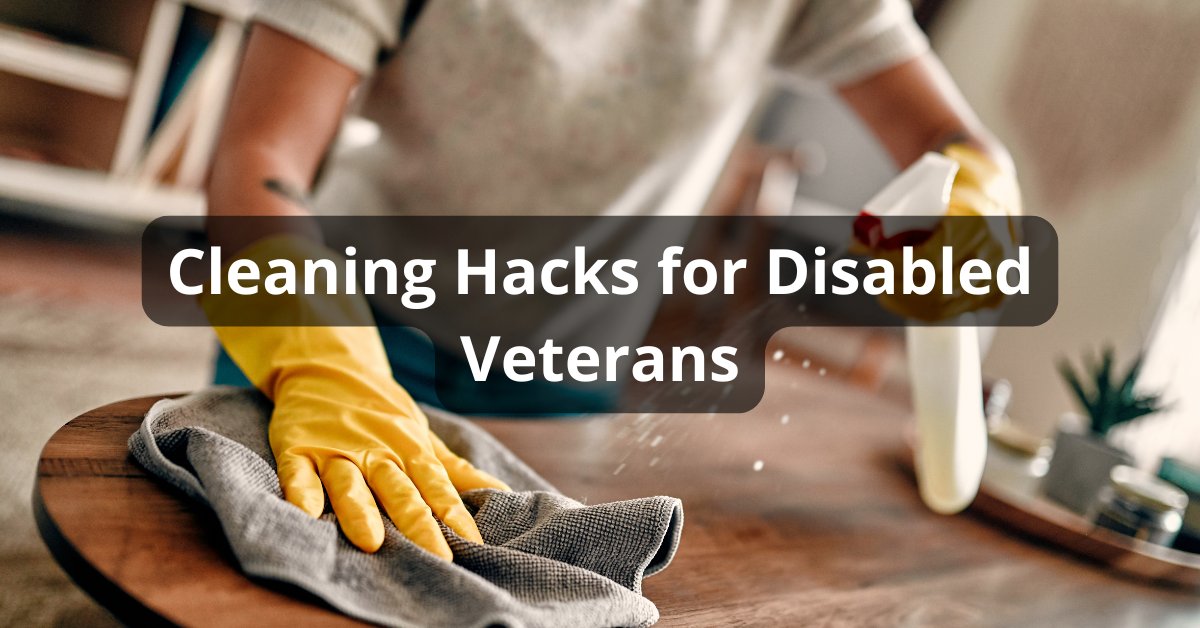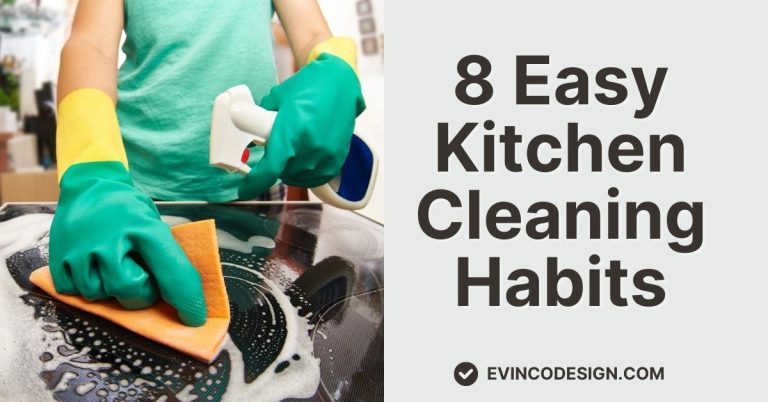11 Empowering Cleaning Hacks for Disabled Veterans

For disabled veterans, daily life often involves navigating physical limitations, chronic pain, and the lasting effects of service. These challenges can make routine tasks—like cleaning—feel especially daunting. Yet, maintaining a clean and organized home isn’t just about aesthetics; it’s essential for physical safety, mental clarity, and a sense of control and independence.
A clutter-free space can reduce the risk of falls, lessen anxiety, and create a more comfortable, manageable living environment. But that doesn’t mean it has to be exhausting or complicated. With the right tools and techniques, cleaning can become more accessible, efficient, and even empowering.
This article offers 11 practical, veteran-friendly cleaning hacks designed to simplify tasks, conserve energy, and promote independence. Whether you’re living alone or with support, these strategies can help you reclaim your space—on your terms.
1. Utilize Lightweight and Ergonomic Cleaning Tools
Heavy, awkward cleaning tools can pose a major challenge for disabled veterans, especially those with limited mobility, joint pain, or strength. The solution? Invest in lightweight, ergonomically designed tools that make cleaning easier and safer.
Cordless stick vacuums are a great example—they’re much lighter than traditional models, easier to maneuver, and can be used without constantly plugging and unplugging. Ergonomic handles and adjustable-length mops or brooms reduce strain on wrists, shoulders, and back. Some tools even come with loop handles or soft grips for better control.
Look for tools labeled “arthritis-friendly” or “ADA-compliant” to ensure they’re built with accessibility in mind. These small investments can significantly ease the physical demands of cleaning, enabling you to maintain your home with less effort and risk.
2. Implement a Room-by-Room Cleaning Schedule
Cleaning an entire home in one go can be overwhelming for anyone—especially for veterans with physical limitations or fatigue. Instead of trying to tackle everything at once, break your cleaning routine into manageable pieces by focusing on one room at a time.
Design a weekly schedule that spreads tasks across the days. For instance:
- Monday: Kitchen counters and dishes
- Tuesday: Living room dusting and vacuuming
- Wednesday: Bathroom surfaces
- Thursday: Bedroom tidy-up and laundry
Use reminders on your phone, a calendar app, or even a whiteboard to stay on track. This strategy reduces physical strain and gives a sense of accomplishment without requiring long cleaning sessions. Keeping it structured but flexible allows you to work within your energy levels while still maintaining a clean home.
3. Leverage Assistive Cleaning Devices
Technology can be a game-changer for disabled veterans looking to keep their living space clean without unnecessary physical exertion. Assistive devices like robotic vacuums, self-cleaning mops, and electric scrubbers are ideal for automating routine chores.
A robotic vacuum, for example, can be scheduled to clean your floors daily—navigating around furniture, avoiding stairs, and keeping pet hair or dirt under control. Electric scrubbers eliminate the need for forceful scrubbing, making them perfect for bathrooms or kitchen stains.
These tools vary in price, but many affordable models are available online or through veteran-focused assistance programs. Investing in technology not only reduces the physical toll of cleaning—it helps maintain independence and comfort in daily life.
4. Adopt the “Clean As You Go” Approach
Maintaining a clean home doesn’t have to mean dedicating long periods to cleaning sessions. The “Clean As You Go” strategy is especially effective for disabled veterans who need to conserve energy and avoid prolonged strain.
After cooking, wipe down counters and rinse used utensils. If you finish a snack, take the plate to the sink right away. Spilled something? Wipe it immediately with a paper towel or handy disinfectant wipe. These small actions, done consistently, prevent buildup and reduce the need for heavier, more time-consuming cleaning later.
Incorporating this habit into daily routines turns cleaning into bite-sized tasks that are easier to manage physically and mentally. It also contributes to a sense of control and helps keep the environment consistently tidy without added stress.
5. Use Long-Handled and Extendable Tools
Bending down, reaching up, or getting into tight spaces can be particularly challenging for those with limited mobility or joint pain. Long-handled and extendable tools offer a safer, more accessible solution.
Extendable dusters, window squeegees, and scrub brushes allow you to clean baseboards, ceiling corners, and even behind furniture without overreaching. Tools with pivoting heads or adjustable angles can further reduce the need for awkward movements.
Many of these products are lightweight and designed with padded grips or looped handles for better comfort and control. By minimizing the need to bend or stretch, you can clean more areas of your home while staying safe and conserving energy.
6. Incorporate Sit-Down Cleaning Techniques
Standing for extended periods or repeatedly moving between rooms can be exhausting or even dangerous for disabled veterans. Wherever possible, bring tasks down to a seated level to reduce fatigue and increase control.
Fold laundry at a table, organize drawers from a seated position, or use a rolling stool to clean lower cabinets. For surfaces like baseboards or tubs, consider using long-handled brushes or stools that allow you to work without kneeling or crouching.
Adjusting your environment—such as setting up a workstation at a dining table or placing bins and supplies at reachable heights—can make a huge difference. Sit-down cleaning promotes comfort and efficiency, allowing you to manage more with less physical effort.
7. Utilize Multi-Purpose Cleaning Products
Managing multiple cleaning supplies can be cumbersome, especially when space, mobility, or dexterity is limited. Multi-purpose cleaning products simplify the process by reducing the number of items you need to store, handle, and apply.
Look for all-in-one sprays or wipes that are safe for use on a variety of surfaces—kitchen counters, bathroom tiles, glass, and even electronics. These products streamline cleaning tasks, eliminating the need to switch tools or carry heavy bottles between rooms.
Opt for eco-friendly, non-toxic formulas, particularly if you deal with respiratory issues or sensitive skin. Concentrated products with refillable bottles are also a great choice—they’re lighter, more economical, and reduce waste. Keeping it simple with just a few trusted cleaners can make regular cleaning quicker and less physically demanding.
8. Delegate Tasks When Necessary
One of the most empowering decisions you can make as a disabled veteran is recognizing when to ask for help. Some tasks may simply be too strenuous or risky, and that’s perfectly okay. Delegating ensures your safety and well-being while keeping your living space clean and comfortable.
Reach out to family, friends, or neighbors for occasional support. Many communities also offer veteran-focused assistance programs or subsidized cleaning services. Some VA programs or non-profits even provide regular housekeeping support for those with disabilities.
Consider hiring a professional cleaning service for deep cleaning once a month, if feasible. It’s a practical solution that allows you to focus your energy on smaller, more manageable daily tasks. Delegation is not a sign of weakness—it’s a smart strategy to preserve your health and independence.
9. Organize Cleaning Supplies for Easy Access
Struggling to find or reach your cleaning tools can be half the battle. Keeping supplies organized and within easy reach makes the cleaning process more efficient and reduces unnecessary movement.
Use portable cleaning caddies with compartments to store essentials like sprays, cloths, gloves, and wipes. Place these in strategic, easily accessible locations—under the kitchen sink, in the bathroom, or near high-traffic areas. If bending is difficult, consider mounting lightweight supply holders at waist or countertop level.
Labeling bottles and keeping only the most-used items in each caddy cuts down on confusion and clutter. With a thoughtful setup, you’ll save energy and time while making cleaning a smoother, less stressful task.
10. Prioritize High-Traffic Areas
For disabled veterans with limited energy or mobility, it’s essential to focus on the areas that make the biggest difference in daily comfort and hygiene. Prioritize cleaning high-traffic areas—like the kitchen, bathroom, and entryways—where mess and bacteria accumulate quickly.
Implement a quick routine: wipe down counters after meals, sanitize bathroom fixtures every couple of days, and vacuum or sweep frequently used pathways. These targeted efforts keep your home feeling fresh and livable without requiring you to clean the entire house at once.
By concentrating your energy on these essential areas, you maintain a clean and safe environment while minimizing physical strain. These efforts also help reduce allergens and prevent the spread of germs, contributing to your overall health.
11. Embrace Minimalism to Reduce Clutter
The less clutter you have, the less there is to clean and navigate around. Embracing minimalism not only simplifies your cleaning routine—it enhances mobility, safety, and peace of mind.
Start by decluttering one small area at a time: a drawer, a shelf, or a corner. Ask yourself if each item is truly necessary or brings you joy. Donate or discard items that serve no clear purpose. Focus on keeping surfaces clear and furniture minimal to make cleaning faster and movement easier.
Choosing furniture and decor that are easy to clean—like smooth surfaces and washable fabrics—further reduces maintenance. A simplified space is easier to keep tidy, safer to move through, and more conducive to relaxation and independence.
Conclusion
Living with a disability doesn’t mean you have to sacrifice cleanliness or independence. With thoughtful planning, smart tools, and adaptive techniques, disabled veterans can maintain a safe, comfortable, and dignified home environment.
These 11 cleaning hacks are about working smarter—not harder. Whether it’s leveraging technology, cleaning from a seated position, or simply asking for help when needed, each strategy is designed to make daily life more manageable. Most importantly, they help you stay in control of your space and your routine.
Your home should support your lifestyle, not challenge it. With these practical tips, you can take back that control—one clean, empowering step at a time.
Resources:
- https://www.thespruce.com/pro-tips-for-accessibility-friendly-house-cleaning-11730947
- https://www.bathingsolutions.co.uk/blog/inspiration/cleaning-hacks/






